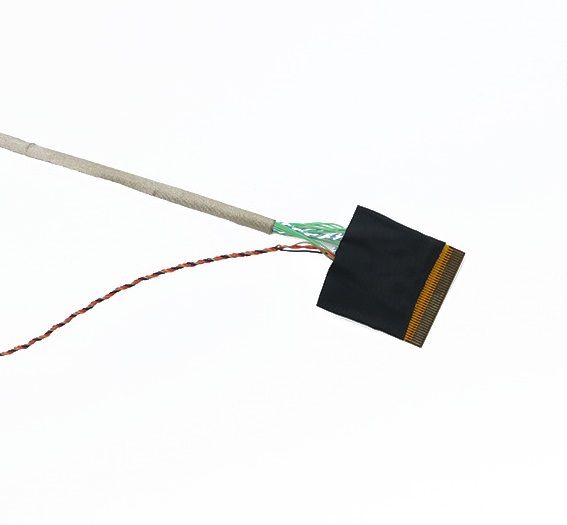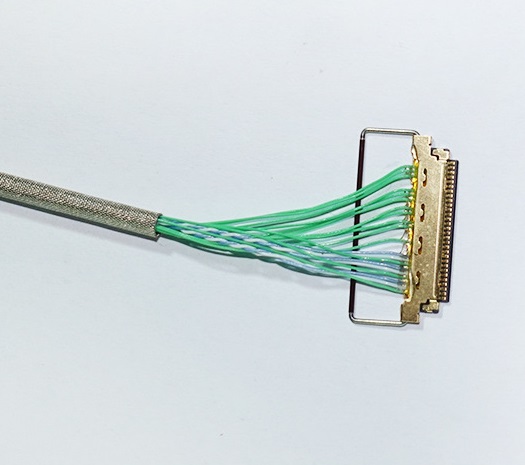What is the difference between EDP Cable and LVDS Cable ?

There are significant differences between EDP (Embedded DisplayPort) cable and LVDS (Low Voltage Differential Signaling) cable in multiple aspects. The following is a detailed explanation:
I. Technology Foundation and Standards
EDP Cable
Technology Foundation: The EDP interface is based on the DisplayPort standard and is an embedded display interface technology. It is designed to connect high-performance display devices such as LCD monitors and OLED displays.
Standards: The EDP interface follows the relevant DisplayPort standards, which define the electrical characteristics, data format, transmission rate, etc., of the interface.
LVDS Cable
Technology Foundation: LVDS is a low-voltage differential signaling technology mainly used to connect display devices such as LCD monitors and touch screens.
Standards: LVDS technology is defined in standards such as IEEE P1596.3 and ANSI/EIA/EIA-644, which specify the electrical characteristics, transmission rate, and other parameters of LVDS.
II. Data Transmission Characteristics

EDP Cable
Transmission Rate: The EDP interface has a high data transmission rate, which can reach 5.4 Gbps or even higher, supporting various display resolutions and refresh rates.
Transmission Method: The EDP interface uses high-speed serial transmission technology to transmit data and adopts 8b/10b encoding to effectively reduce the error rate during data transmission.
Signal Integrity: The EDP interface has high requirements for signal quality and requires high-quality transmission lines and interface design to ensure signal integrity and stability.
LVDS Cable
Transmission Rate: The LVDS interface has a relatively low data transmission rate, typically around 1 Gbps, and supports lower display resolutions and refresh rates.
Transmission Method: The LVDS interface works based on differential signaling technology, transmitting opposite signals on two lines to achieve data transmission, which has low power consumption and high anti-interference ability.
Signal Integrity: The signal integrity of the LVDS interface is relatively good, but due to its lower transmission rate, it may be limited in high-definition display applications.
III. Application Scenarios
EDP Cable
Main Applications: The EDP interface is mainly used in high-performance display devices such as LCD monitors and OLED displays. In the industrial field, the EDP interface is also widely used in industrial automation, medical equipment, and other areas to achieve data visualization and operation control.
Advantages: The EDP interface supports high resolution, high refresh rate, and high bandwidth, meeting the needs of high-performance display devices such as high-definition displays. At the same time, the EDP interface has the advantages of a simple circuit and no need for LVDS conversion circuits.
LVDS Cable
Main Applications: The LVDS interface is mainly used in portable devices, in-vehicle displays, and other applications. In addition, the LVDS interface is commonly used in devices such as touch screens and small displays, as well as for long-distance data transmission in video surveillance systems, medical equipment, and aerospace fields.
Advantages: The LVDS interface has the characteristics of low power consumption, low electromagnetic interference, and long transmission distance, making it suitable for portable devices and cost-sensitive applications. At the same time, the cost of the LVDS interface is relatively low, which is beneficial for reducing the overall cost of the device.
IV. Cost and Compatibility
EDP Cable
Cost: The manufacturing cost of the EDP interface is relatively high, which may lead to an increase in the price of display devices.
Compatibility: Some older display devices may not support the EDP interface, resulting in compatibility issues. However, as technology develops, more and more new devices are beginning to support the EDP interface.
LVDS Cable
Cost: The low power consumption and low cost of the LVDS interface make it more advantageous in portable devices and cost-sensitive applications.
Compatibility: The LVDS interface has been widely adopted and supported, with good compatibility.
V. Physical Characteristics
EDP Cable
Screen Interface: The screen interface of the EDP cable is a 0.3-0.5 small-pitch welded flat cable, divided into single-channel and dual-channel.
Number of Twisted Pairs: EDP cables generally have 2, 3, 5, or 8 sets of twisted pairs. Common EDP cables have 2 or 3 sets of signal twisted pairs.
Advantages: The relatively small number of twisted pairs in
Cnomax EDP cables helps reduce the space and weight occupied by the transmission lines.
LVDS Cable
Screen Interface: LVDS cables are divided into standard-definition and high-definition cables. The screen interface of high-definition cables is a 0.5-pitch double-row (such as JAE FIRE51P high-definition cable); the screen interface of standard-definition cables is 1.0-pitch, 1.25-pitch, etc., with terminals assembled through riveting.
Number of Twisted Pairs: LVDS cables have a relatively large number of twisted pairs to meet their lower transmission rate and higher anti-interference requirements.
Advantages: The differential signaling transmission method of LVDS cables provides strong resistance to common-mode noise, helping to ensure signal stability and reliability.
In summary, there are significant differences between EDP cables and LVDS cables in terms of technology foundation, data transmission characteristics, application scenarios, cost and compatibility, and physical characteristics. In practical applications, it is necessary to select the appropriate interface technology based on specific needs and scenarios.

